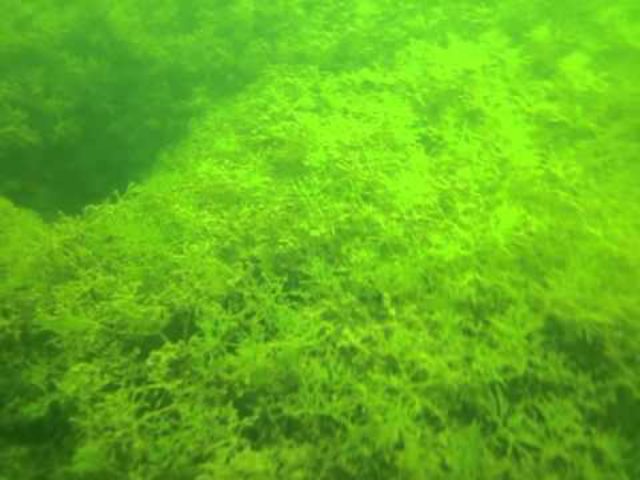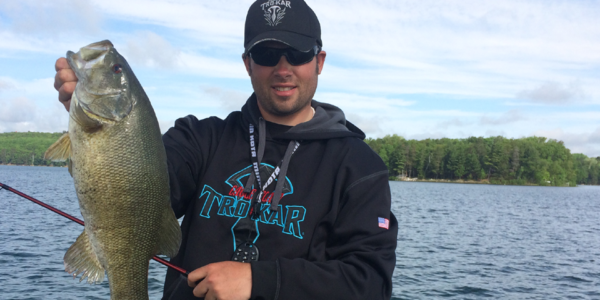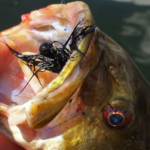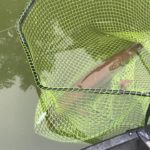By Andrew Ragas
Clustered throughout northern Wisconsin’s wilderness landscape is the upper Midwest’s most extensive collection of inland freshwater lakes. From infertile rocky oligotrophic cold water lakes, to fertile habitat mesotrophic lakes, and heavily vegetated and nutrient-rich eutrophic waters, the northwoods has a lake type for all bass fishermen and their preferred styles of angling.
The diversity of lakes is so huge in terms of size, configuration, water chemistry, and biota. Complex factors such as soil, topography, bottom composition, and fertility all combine together to help determine the physical and chemical characteristics of any given lake, which then sets up its bass fishery.
The two most common smallmouth bass lake types of northern Wisconsin are oligotrophic and mesotrophic lakes. Majority of the lakes under these two classifications possess detailed underwater terrain and topography, and a food chain of forage suitable to smallmouths. These waters are rich and plentiful with rock habitat and hard bottom, and fluctuating depths and deep underwater structures. They are dominated by a biomass of crayfish forage and pelagic baitfish species. Their attractiveness on maps and physical features aesthetically appeal to smallmouth fishermen the most, compelling anglers to fish them prominently. I always say the more topography and habitat the likelihood of better smallmouth fishing. Sometimes it’s not the case. In midsummer and fall it could be the exact opposite.

The technique excels in lakes with high transparency, limited nutrient growth, and that are otherwise dull in structure.
While every lake is comprised of unique characteristics and physical features appealing to anglers, there are many waters dull in topography and greatly lack topographical features. The terrain of these lakes is mostly open water basins of moderate depth with high consistency, little distinguishable underwater structure, and poor contour. Rock habitat may be sparse, sand bottom abounds, and some artificial habitats such as fish cribs and laydowns may have been dropped because the lake might not feature much of anything else. The fishery might be somewhat infertile, but the smallmouths could care less as they’ve adapted to look beyond the obvious for their living quarters. Boring looking on the map and Navionics chart but interesting on the sonar, down deep in its waters of infertility and high transparency blankets the bottom a complex organism serving as the lake’s cradle of life, and provider of health and fisheries well-being. Sand grass!
Sand Grass Characteristics
 Sand grass, commonly referred to as chara and nitella, is the most advanced form of algae. Often mistaken for a plant, it’s a complex organism that continually photosynthesizes to the sun and grows year-round into short thick mats, commonly blanketing across the lake’s basin in depths of 15 to 25 feet. It is branched with no root system, and may grow upward into the water column providing an even greater attraction and appeal for fish species. Sand grass is light green and yellow in color, and its stems and branches are hollow with rough ends. When crushed, it emits a foul musty scent.
Sand grass, commonly referred to as chara and nitella, is the most advanced form of algae. Often mistaken for a plant, it’s a complex organism that continually photosynthesizes to the sun and grows year-round into short thick mats, commonly blanketing across the lake’s basin in depths of 15 to 25 feet. It is branched with no root system, and may grow upward into the water column providing an even greater attraction and appeal for fish species. Sand grass is light green and yellow in color, and its stems and branches are hollow with rough ends. When crushed, it emits a foul musty scent.
In all lakes where it’s established, sand grass is an integral component to the lake’s habitat and health of fisheries. Chara and nitella is a promoter of clear water clarity and bottom stabilization, prevents sediment build-up, and slows the aging process of lakes. It drives the ecosystem and fishery to a high degree that it provides food and cover for macroinvertibrates, forage species, and predators. Last, it produces rich oxygen content for the entire lake’s biomass and is the epicenter of an entire lake’s food web. Henceforth sand grass is the cradle of life on these waters.
Lake Locations
Many lakes with sand grass rear healthy populations of smallmouth bass. Fish in these waters quickly adapt with their lake’s available habitat for spawning, feeding, and homing.
Sand grass is unique that it grows in deeper water than any other aquatic plant, and often is the only deep water cover available in lakes.
The peak growth of sand grass is in summertime months, as sunlight penetration is greatest. The sand grass pattern begins to take shape in mid summer (late June at earliest) as fish have begun their post-spawn feeding activities and movements and surface temperatures have surpassed 70 degrees. The sand grass bite fully establishes by July during the summer peak when thermoclines typically form on some lakes, driving smallmouths to seek deeper, cooler depths with structure and cover for sanctuary and homing. It is at these mid depth ranges of 15 to 25 ft. where the lake’s water temperature is coolest, oxygen content is richest, and habitat is mostly sand grass. Smallmouths, and most other species in the lake, gravitate to these locations where a major percentage of the lake’s population may remain full-time through fall.
While sand grass can blanket the entire lake bottom, finding smallmouths on their expansive beds can be more difficult. Large sand grass flats will scatter smallmouths throughout, but thicker clumps with unique features that may grow upward into the water column and specific spots differentiating from most other areas of the bed are best. Open pockets in between clumps and grass beds are high percentage locations as well, providing smallmouths with ambush points. These slight differences will attract schools of fish.
Without scanning, little in terms of sand grass consistency, depth range, size of the clump, and its attractiveness and propensity to hold forage and smallmouths can be deciphered. Charting with Navionics, and scanning the lake’s basin with a combination of side-imaging and chirp sonar is huge for this precision fishing strategy. These tools will be able to tell you everything about the lake and a specific region of the lake and its grass bed that otherwise a charted paper map could not, and wouldn’t have ever shown.
On lakes I know that are rich in sand grass habitat and poor in structure and topography, I spend some time charting its waters and basin prior to fishing. I intently study my screens and zig zag a section of the ake’s basin nearest to its undefined and unpronounced structure and contour. My scanning will often begin within proximity to a secondary point, a deep hump, along the deep edge of a shoreline flat or extension leading to deep water, and the deeper regions located beyond fish cribs that are commonly submerged at 15 ft. depths on these clear infertile waters. I am generous with marking waypoints over sand grass clumps and whenever I have marked schools of baitfish and smallmouths. Seeing baitfish, schools of yellow perch and bluegills on the screen, in addition to smallmouths coughing up partially digested forage, is a sign of a good area. Once my starting points and fish locations are zoned in, it’s time to run some precision boat control and deploy my seek and destroy unit of baits. The fishing at this point turns itself into a highly engaging and entertaining video game.

Sometimes it’s not always about catching the biggest fish in the lake. August 2016 guide client, John Patin, holds a few rod benders from our 60 fish morning of bass in the grass.
Way Better than a Playstation
When hosting my guests for the day, I fish and instruct from my Ranger’s rear casting deck. This affords me the luxury of paying attention to my Lowrance big screen at the console, and to control the Minn Kota Terrova trolling motor with remote control and its foot pedal when necessary. As I see clumps of sand grass and indentations of fish on the side imaging, Lowrance Elite 12 TI at the front deck will produce the same picture. I can then instruct my guests in which direction or what distance to flip their drop shot rigs and jigging plastics away from the boat. On the sonar and down imaging, I can also instruct them when we’re parked over a school of active smallmouths and they’ll be able to see the same detail from the networked screen I keep at the front deck as well.

Sandgrass is the cradle of life on structurally dull, non vegetated lakes. Most productive sandgrass is located in the lake’s main basin. It draws baitfish and attracts large midsummer smallmouths like this 21 inch specimen that was taken on a drop shot rig.
Smallmouth schools are commonly wolfpacks of 10 to 20 fish, sometimes more if they’re active and feeding heavily. When we are on top of the schools, I park the boat with spot lock and we all jig and drop shot different styles of soft plastics within range of the boat’s transom and bow-mount transducers. Fishing and navigating from the back of the boat, while paying attention to the big screen in front of me, I can see everything that’s going on around us underwater, including strikes.
Fishing sand grass isn’t all too tricky. With some type of a vertical jig and plastic combination or a drop shot rig, my seek and destroy unit is an unbeatable combination for these open water basin smallmouths. Soft plastics and finesse offerings fished with fast action rods and light lines dominate. Not once is anything ever casted far off into the depths. We fish our targeted sand grass clumps as vertically under and near to the boat as possible.
Drop shot rigs are unquestionably the easiest presentations to coax sand grass dwelling smallmouths with. The ability to read electronics and having a magic touch and feel for the rig surely makes a difference though. With a skinny 3/16 to ¼ oz. drop shot sinker and minimally exposed hook, the vertical format of the rig enables you to work the plastic offering through the grass without snagging its branches. The drop shot rig is the most weedless and favorable presentation of them all, putting sheer numbers of bass into the boat. Rigged with size 1 Trokar TK230 Helix Drop Shot Hook, or TK180 Finesse Worm hook presented weedless, any finesse soft bait can be successfully fished through sand grass. If the hook does catch tiny branchlets, give the rod a quick snap to free the rig from interference.
Most sand grass smallmouth waters don’t have crayfish in them, so the lake’s forage is driven by a biomass of juvenile yellow perch, bluegills, and shiners. In vicinity of sand grass clumps, smallmouths often chase the baitfish against grass walls. They’ll also cruise around in wolfpacks looking for them.

Finesse plastics and micro-snacks like the Stankxbaitco 3.5 DS Squirtz are a favorite for drop shotting in sandgrass.
Therefore minnow imitating smallmouth snacks are most ideal. Minnow profile favorites for drop shot rigging is the 3” Stankx Bait Company DS Squirtz, 3” Bass Assassin Shad Assassin, any clear translucent 4” stick worm or jig worm, and anything resembling a juvenile minnow and baitfish species. Due to high transparency, matching the hatch on sand grass lakes is a good strategy to follow.
With a 7 foot medium light to medium fast action rod and reel spooled with super thin braided main line such as 10 and 15 lb. Cortland Masterbraid, a 3-foot section of 10 lb. Seaguar fluorocarbon attached by a blood knot or seaguar knot, the sand grass bottom will be felt from the pounding of the drop shot sinker and bites will be detected.
Fished with the same light spinning tackle, jigging a minnow style darter head paired with a 3” and 4” fluke minnow in front of fish is a good secondary option. Favorites are 4” and 5” Kalins Jerk Minnows, 5.25” Stankx Bait Co. Jerx, and a Gnugen Live Minnow. While one angler is working the drop shot, another must hover a minnow down below the boat. Additionally, a 3 inch Strike King Coffee Tube rigged with a 1/16 to 1/8 oz. internal tube jig insert is good for backup too, as it can glide and pop throughout the water column to trigger more aggressive fish. It’s fairly grass resistant as well.
Besides these offerings a number of other presentations can surely work, including weedless jigs, livebait rigs, Carolina rigged plastics, and vertically jigged blade baits and spoons. But those tactics are best reserved for the fall season under different circumstances.
Fished entirely with light action spinning rods and reels, midsummer bass in the grass tactics have saved many scorching hot midsummer afternoons from futility, with rod benders aplenty.
Trips of enormous numbers, unparalleled excitement, and some occasional giants are to be had. The style of fishing isn’t too technical other than the requirement of precise boat control in conjunction with the ability to map and pinpoint smallmouth-holding sand grass locations.
Savvy smallmouth anglers seldom hesitate to try the habitat and natural structure of sand grass that provides a major source of food and cover. Even if it may seem that it’s not normally associated with smallmouth, it’s been proven to be a fish magnet and the cradle of life in all northern Wisconsin lakes, wherever present.

Fishing partner and smallmouth expert, Johnny Amato, observes a Vilas County, WI 20 incher that was taken from a midlake sandgrass patch.
Northwoods Bass Fishing Adventures is Wisconsin’s number-1 resource for world-class smallmouth bass fishing information, conservation, and angling instruction. Located in Minocqua, Wisconsin, Andrew Ragas fishes the waters of Vilas, Iron, and Oneida Counties exclusively for trophy bass, and looks forward to hosting you. Schedule your fishing trip with us today!







